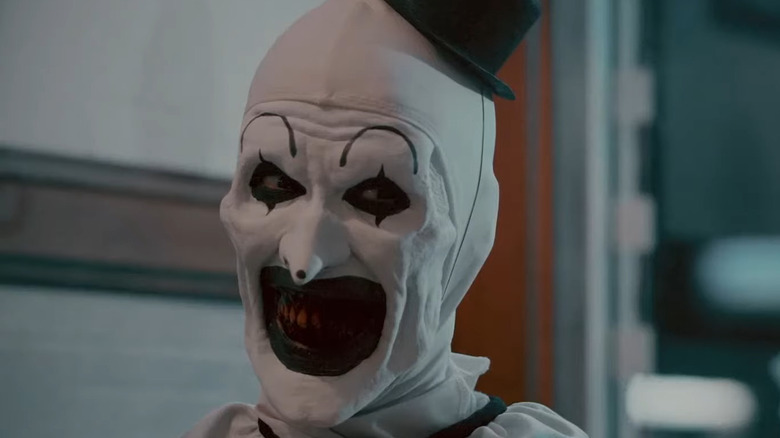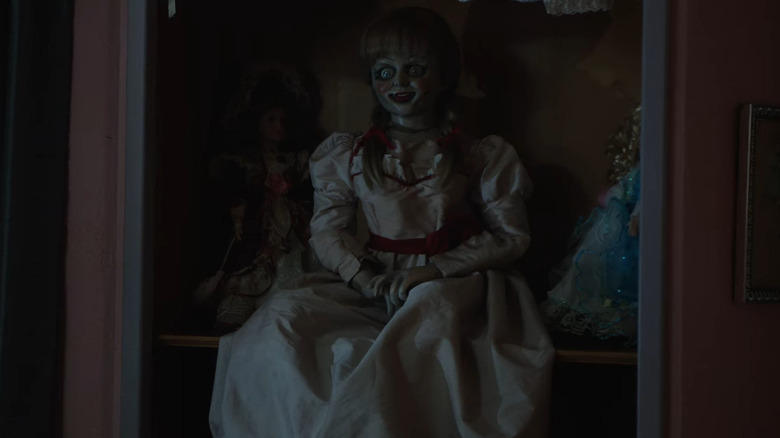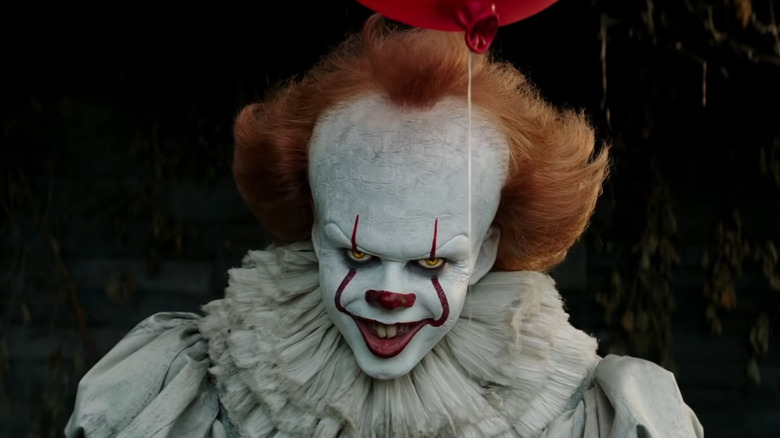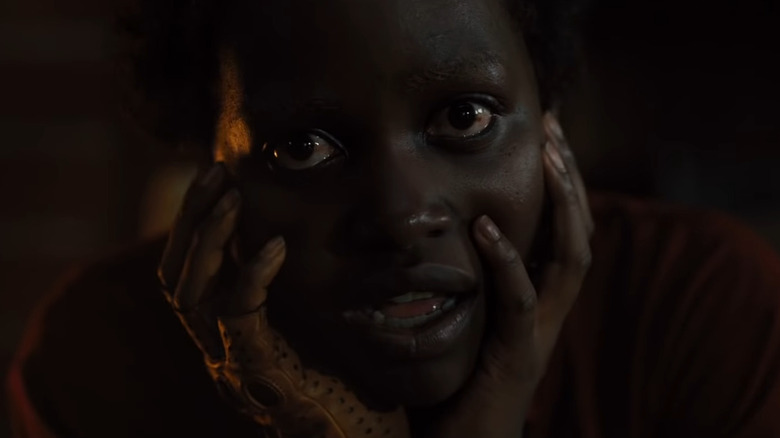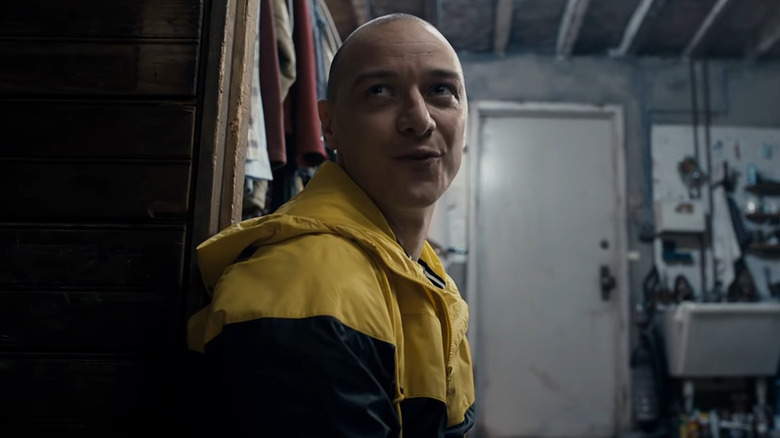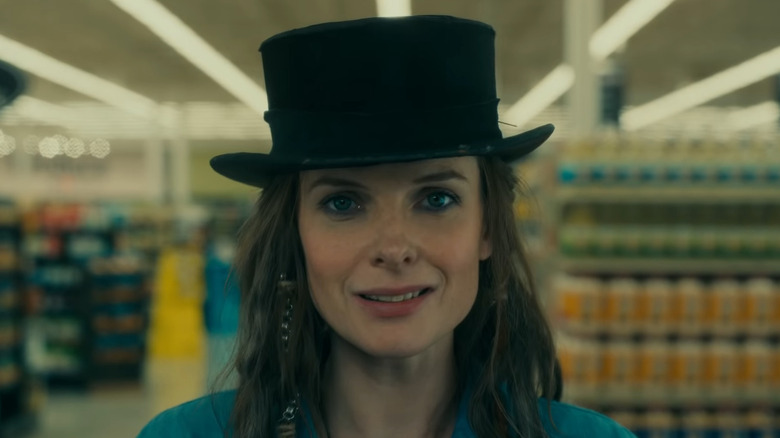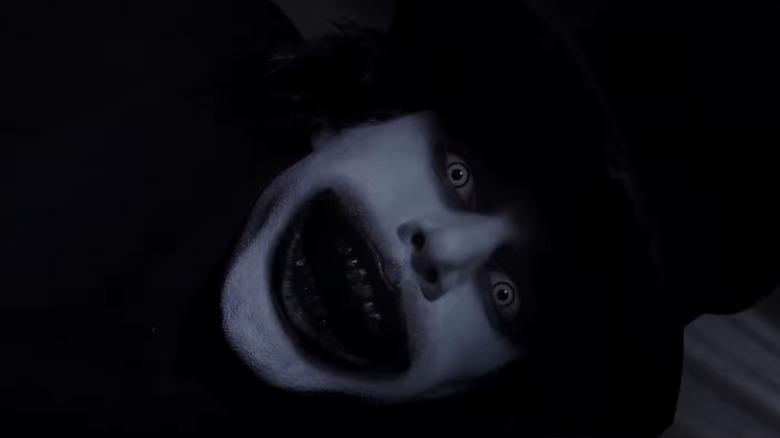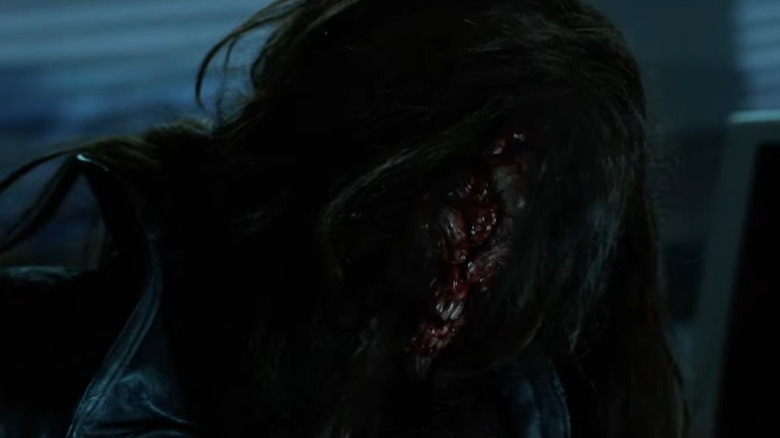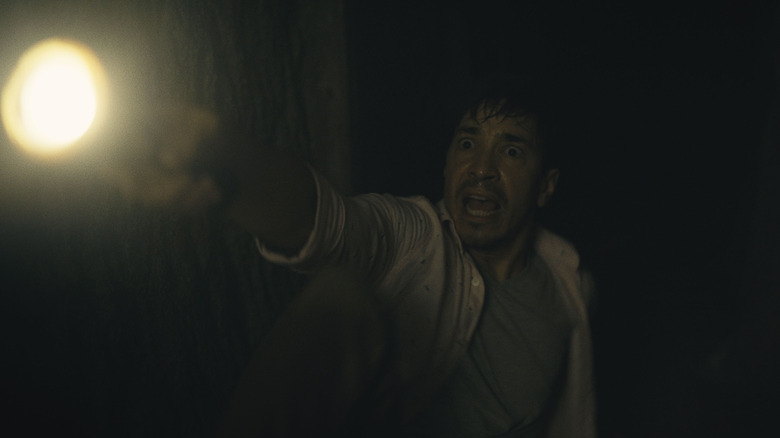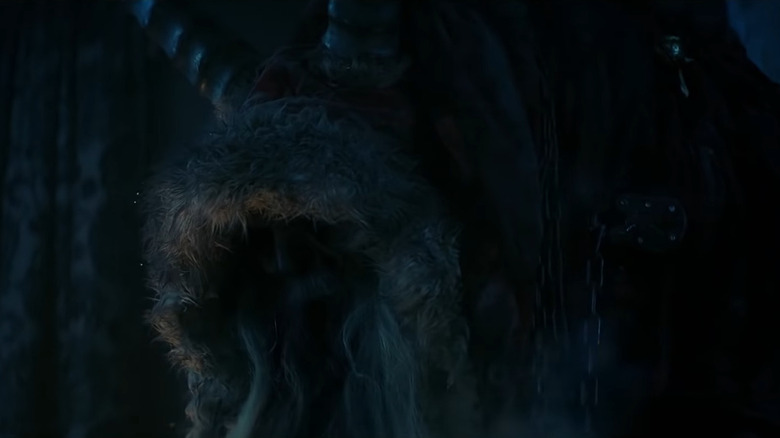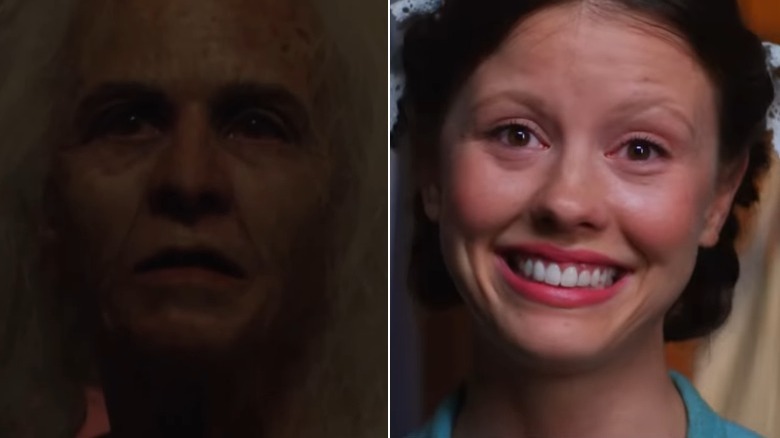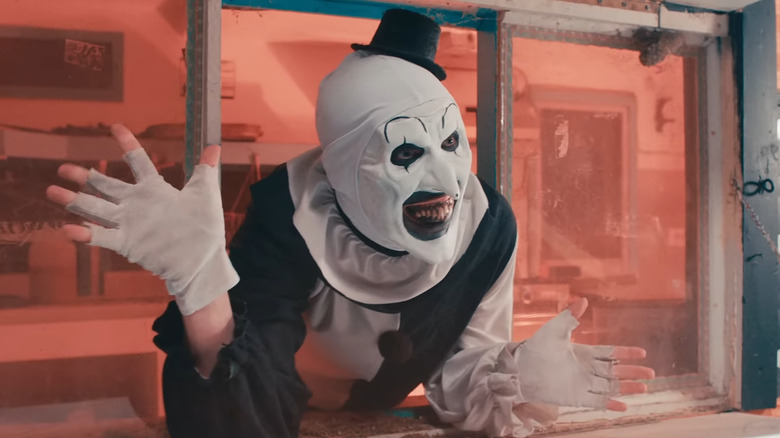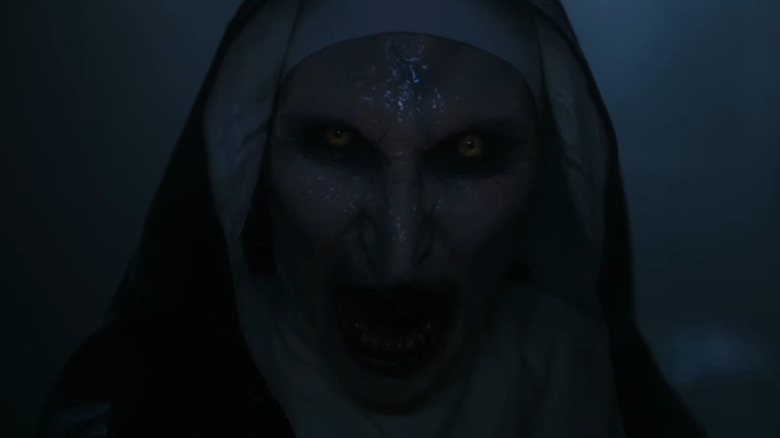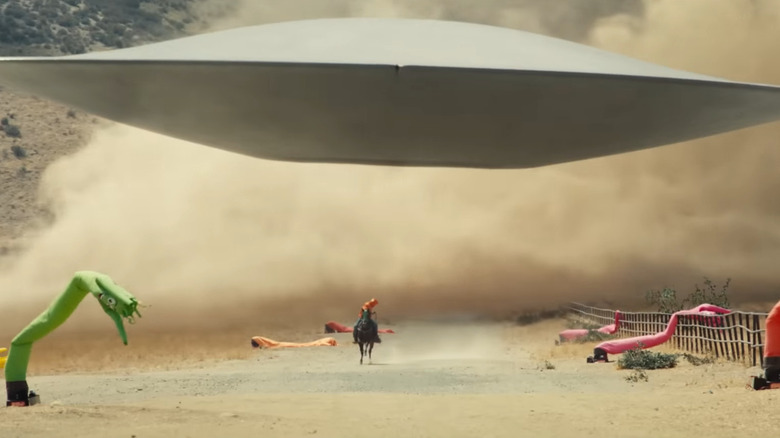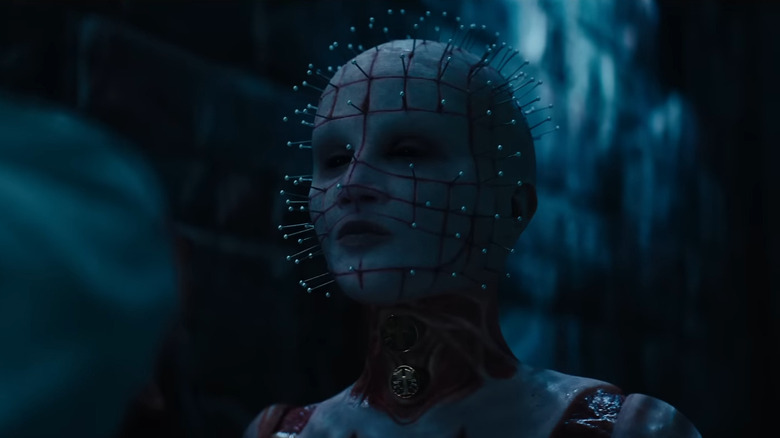14 Scary Modern Horror Villains That Totally Creep Us Out
Warning: The below feature contains major spoilers for the films mentioned.
A great villain can elevate even the most pedestrian horror movies into memorable films. Take the Friday the 13th franchise as an example: It started as a generic slasher film in the mold of "Halloween." However, it evolved into a 12-film series once its sequel introduced Jason Voorhees, a hockey-masked serial killer. He struck such a chord in the public consciousness that people who have never seen a single "Friday the 13th" film know who he is solely by his appearance.
Throughout the '80s and '90s, a host of iconic horror villains came to the forefront — from the nightmare-stalking Freddy Krueger to the possessed doll Chucky to the self-aware slasher(s) Ghostface. Their iconographies have lived long after many of their respective franchises withered. Once the slasher subgenre started to wane in popularity, audiences saw fewer villains find the same level of notoriety.
Fortunately, we are now in a golden era of horror. Older franchises like Halloween have received a fresh coat of paint and new franchises arriving on the scene to stake out their own territory like Ti West's "X" trilogy. With that, a slate of reimagined horror villains has made an indelible impression. Here are 14 horror villains from the last decade that give us chills!
Annabelle
What started as an urban legend about a supposedly possessed Raggedy Ann doll has blossomed into a robust trilogy of wildly successful horror films. Annabelle became reimagined as a vintage porcelain doll in a white dress in 2013's "The Conjuring." She appeared as one of many demonic entities encountered by paranormal investigators Ed (Patrick Wilson) and Lorraine Warren (Vera Farmiga). Though James Wan's film takes a few liberties with the story of the real-life ghost hunters, it kickstarted a creepy cinematic universe, and the effortlessly creepy Annabelle became the first subject worthy of a solo film.
In 2014, "Annabelle" debuted, which was followed by the prequel "Annabelle: Creation" in 2017 and the sequel "Annabelle Comes Home" in 2019. Throughout the film series, we learn how Annabelle came to life: A dollmaker made her in the early 1940s after her daughter died in a terrible accident. After he and his wife are visited by a mysterious (read: demonic) spirit, they mistakenly believe it to be their daughter and let it inhabit the doll. The spirit's malevolent, soul-hungry intentions are quickly made clear. Despite multiple attempts to destroy it, the demonic entity has always found a way to return and wreak further havoc upon generations of unsuspecting victims. Although the doll itself doesn't move much, the evil that embodies it is more than fearsome enough.
Pennywise
Stephen King's 1986 novel "It" introduced a new kind of terror: a shapeshifting monster that most frequently appears in the form of a playful but sinister clown. In 1990, a miniseries adaptation of the book gifted audiences with a delightfully unhinged performance by the great Tim Curry, who stepped into the oversized shoes of Pennywise the Dancing Clown and scarred a whole generation of impressionable young audiences. Fast forward to 2017, and a big-budget, R-rated version of the story hit the big screens with a new actor taking up the mantle.
Bill Skarsgård portrays Pennywise in the newer adaptations. Thanks to unsettling makeup, CGI enhancements, and some demented line deliveries, Skarsgård redefined Pennywise for the modern era. Throughout 2017's "It" and its sequel "It: Chapter 2," he stalks the children of Derry, Maine. Sometimes, it's the creepy clown. Other times, it materializes their worst fear — ranging from an abusive father to a living painting. When the now-grown group of friends return to their hometown and face off against Pennywise in its underground lair, they confront a horrifying hybrid of its clown form and a giant spider. Even after defeating it, one imagines its crooked smile and sinister laugh will continue to haunt them (and us) for a long time.
Red
Sometimes, the scariest thing a character can see in a movie is themselves. Or a distorted, funhouse-mirror version of you, intent on destroying everything you hold dear. This evil double is one of the core concepts behind Jordan Peele's cerebral 2019 horror film "Us." The film follows a family on a vacation that's disturbed by the arrival of four doppelgängers that look uncannily like them. Parents Adelaide (Lupita Nyong'o) and Gabe (Winston Duke) and their children Zora (Shahadi Wright Joseph) and Jason (Evan Alex) have to escape hunted by clones garbed in red jumpsuits and wielding golden scissors, with expectedly gruesome results.
Though the doppelgängers are all effectively creepy through their menacing stature and silent demeanor, the highlight is Red (also played by Nyong'o). Despite having lived in an abandoned underground facility for years, she's developed the ability to speak — albeit in a hauntingly hoarse cadence guaranteed to make the hair on your neck stand up. Red leads the charge against their duplicate family and has a bone to pick with the outside world — especially with Adelaide. After a series of bloody encounters, the original family dispatches their copies and reaches safety. However, a final plot twist leads the viewer to question who the real monster is. Its ending throws everything we've seen up to that point into a brand-new light.
The Horde
Between his roles as a benevolent faun in "The Chronicles of Narnia: The Lion, the Witch and the Wardrobe," Professor Xavier in the "X-Men" films, or a corrupt cop in "Filth," it's clear James McAvoy has considerable acting talent. Still, it was surprising to see how much range he showcased in M. Night Shyamalan's "Split." He portrays Kevin, a young man with 23 distinctive personalities. We meet Kevin at the start of "Split" after he abducts a girl (Anya Taylor-Joy) with deep-seated trauma and two others from a birthday party. He plans to use them as sacrifices for a nefarious ritual.
Despite his psychiatrist's (Betty Buckley) best attempts, he successfully summons a powerful and incredibly violent 24th persona known as "The Beast." The Beast has plans to rid the world of the impure, which translates to anyone who has not suffered. Collectively known as "The Horde," Kevin's alters return in Shyamalan's 2019 sequel, "Glass," and Elijah Price (Samuel L. Jackson) manipulates them to spread awareness of the existence of superheroes and villains. Kevin's history of abuse and McAvoy's go-for-broke performance make the character feel almost sympathetic, but then we remember his body count.
Rose the Hat
Crafting a sequel to "The Shining," one of Stephen King's most celebrated books and film adaptations (even though he hates it), was a Herculean task. So it was a pleasant surprise that "The Haunting of Hill House" director Mike Flanagan adapted King's sequel novel "Doctor Sleep" into a thoughtful and effectively scary film. The story follows the grown-up Danny Torrance (Ewan McGregor) grappling with his scarring experiences in the Overlook Hotel. However, he gradually learns to use his ability to "shine" for good, aided by his friendship with a young fellow psychic named Abra (Kyliegh Curran).
Even more impressive than the sequel's ability to follow "The Shining" is its ability to create a villain just as memorable as any of the hotel's ghostly denizens. Rose the Hat, played to perfection by Rebecca Ferguson, leads a clan of psychic vampires that hunt and drain the essence from anyone who has the shining. As sinister as she is seductive, Rose and her crew hunt Danny and Abra back to the Overlook, which Danny guides them to in the hopes of unleashing the hotel's unnatural residents against their pursuer. Although this ultimately costs Danny his life, Rose puts up a hell of a fight!
The Babadook
"If it's in a word or it's in a look, you can't get rid of the Babadook." These are the opening words of a mysterious pop-up book that appears in the home of the widow Amelia (Essie Davis) and her troubled son Samuel (Noah Wiseman) near the beginning of Jennifer Kent's seminal 2014 feature debut, "The Babadook." Amelia grieves her husband and struggles to deal with a child that now exhibits behavioral issues. So when the title character starts to make his presence known, first in subtle ways and then with increasing aggression, it pushes their already fracturing family dynamic to its breaking point.
The creature resembles a tall man dressed in all black with a top hat. He has long fingers, messy hair, and a ghost-white face. Although he's rarely sighted outside of a silhouette, Timothy John Purcell's Babadook creates a strong impression through a combination of spooky voiceover and stop-motion animation. While it's arguable that the monster in "The Babadook" is more of a metaphor for Amelia's grief, the scenes where the Babadook turns her into a ferocious wraith intent on killing her child will feel scary enough. Most audiences will have nightmares long after the credits have rolled.
Gabriel
Sometimes, a horror villain will make their presence known from the beginning, providing audiences with a visible and distinctive source of terror for the remaining runtime. Others will show up around the halfway point as a way to raise a movie's stakes and unveil the threat to its main characters. Still, others don't appear until the film's third act, usually delivering a big surprise twist. The latter example was the case with James Wan's bonkers 2021 slasher film, "Malignant," which follows Madison (Annabelle Wallis), a woman who receives visions of murdered people, only to discover that the deaths are all too real.
For most of the runtime, "Malignant" is coy about what's happening. Has Madison gone crazy? Is there a ghostly entity tied to her? Not even close: it turns out that the killer was living on the back of her head the whole time! Enter Gabriel (voiced by Ray Chase and portrayed by contortionist Marina Mazepa), her siamese twin that shares her brain and manipulates their body to homicidal ends. On a quest for revenge against the doctors who tried to amputate him, Gabriel carves a bloody swath throughout the film. "Malignant" nails an outrageously over-the-top massacre inside a police station for its big finish. We hope a sequel will eventually arrive to showcase further adventures from this inventive psycho!
The Mother
Give credit to the marketing team behind "The Whitest Kids U' Know" alumni Zach Cregger's horror debut, "Barbarian." Based on the trailer for the film, you would know very little about what happens beyond the first 10 minutes. You wouldn't imagine Justin Long arrives at around 40 minutes into the runtime to co-lead the film. You'd never guess that the film jumps back to a 1980s flashback featuring genre stalwart Richard Brake. You certainly wouldn't know about the main monster, a deformed giant woman living in the basement of the Airbnb from hell, known as the Mother.
Portrayed with menace and surprising emotion by Matthew Patrick Davis, the Mother is the result of a horrific string of incidents involving kidnapping, rape, and incest over decades. Despite living in the basement and only emerging at nighttime to hunt, the gangly woman desires motherhood more than anything else. She locks her victims in her underground cage and attempts to feed them from perhaps the grossest milk bottle ever put on screen. Her fate at the end of the film renders any potential sequels unlikely. However, the Mother's final moments reveal a desperate tenderness that's rare to see from most horror villains. "Barbarian" highlights that despite being the signature creature of this feature, her father is the real monster in these circumstances.
Krampus
Obviously, Halloween is the holiday best associated with horror, but that doesn't mean other holidays can't get in on the fun too! There have been more than a few Christmas-themed genre outings, from early slashers like "Black Christmas" to later creature features like "Gremlins." But in 2015, "Trick 'r Treat" director Michael Dougherty delivered perhaps the definitive Christmas horror movie: "Krampus." Telling the story of a dysfunctional family whose infighting causes their young son (Emjay Anthony) to shred his letter to Santa in defiance of the festivities, the film descends into a haunted house of horrors. All manner of distorted holiday-themed monsters come out of the woodwork to wreak havoc.
The instigators include demonic elves, cursed gingerbread men, and lethal presents. But all of them serve a master: Krampus. He emerges towards the end looking like a macabre Santa Claus with hooves for feet and massive horns emerging from his cloak. The pitiless harbinger of the dark side of Christmas oversees the destruction of the entire extended family. After the son wakes up and thinks this ordeal was a dream, we learn they are still prisoners in Krampus's lair, doomed to spend eternity repenting for their lack of holiday cheer.
Pearl
One of the most recent entries on this list made her debut in two separate 2022 releases, which is impressive even by the lightning-fast turnaround production times afforded to most horror sequels. Director Ti West shot his latest slasher movie and its prequel back-to-back — thanks to some unexpected Covid delays — resulting first in "X" and then "Pearl" six months later. The first film takes place in the late '70s and follows a group of aspiring filmmakers shooting a porno while renting a cabin on a massive but isolated farm. They gradually learn that the couple owning the farm are deeply disturbed and don't take kindly to their guests' activities, resulting in a massacre.
In an inspired bit of double-casting, Mia Goth portrays the lone survivor Maxine and the elderly killer Pearl. In case you didn't get enough of the homicidal Pearl in "X," the filmmakers have you covered with "Pearl." Set in 1918, "Pearl" reveals how the small-town farm girl with dreams of superstardom became the psychotic killer we saw in the previous film. Goth returns to play a younger version of the character and instantly cements herself in the annals of horror history with a delightfully unhinged performance. Viewers glimpse all the various cracks that form in Pearl's psyche until she can no longer restrain her violent urges.
Art the Clown
Though there have been decades of horror villains taking various forms, it's rare for one to have the unique look and personality needed to stand against genre legends like Hannibal Lecter. Art, the Clown is the rare exception: a silent serial killer dressed as a black and white clown who oozes so much presence on screen that he launched an entire franchise based on the intrigue surrounding the character. Introduced in 2013's anthology "All Hallow's Eve" (the feature directing debut of franchise creator and special effects wizard Damien Leone), Mike Giannelli portrayed Art. Several years later, Art earned center stage in "Terrifier" with David Howard Thornton playing the killer clown.
With a creepy smile, a playfully vicious demeanor, and a trash bag filled with razor-sharp implements to torture his victims, Art is a killer that likes to toy with his prey before doing the deed. He'll embrace the clown gimmick by riding around on a tricycle or honking a toy horn, then brutally dismember someone. "Terrifier 2" expanded his mythology, introducing a twisted little girl — who may or may not exist — and a potentially supernatural ability to cheat death, suggesting there's plenty more to see from Art in the future.
The Nun
Another insidious member of the cinematic universe established in James Wan's "The Conjuring," the Nun made her first appearance in the director's sequel, "The Conjuring 2," where she terrorizes Ed and Lorraine Warren (Patrick Wilson and Vera Farmiga) as one of several forms taken on by the demon Valak. The character design, distinctively inhabited by actress Bonnie Aarons, proved memorable and scary enough to warrant a spin-off/prequel, which it eventually got courtesy of 2018's "The Nun," this time directed by Corin Hardy. Delving more deeply into the entity's origins, the 1952-set film stars Vera's sister Taissa Farmiga and Demián Bichir as a nun and exorcist, respectively, who investigate the unnatural happenings of a Romanian monastery.
Their journey eventually leads them to discover the story behind Valak, who was summoned in the Middle Ages by an occult-obsessed duke, but was sealed by the blood of Christ by the knights of the time before being accidentally reawakened as a result of World War II bombing runs. It now takes on the gaunt features and glowing yellow eyes of the demon Nun, whom the protagonists are forced to evade and eventually confront. Though it initially appears that they are successful at banishing the demon, we discover that it has in fact possessed one of their cohorts (Jonas Bloquet). Between a cameo in "Annabelle: Creation" and a sequel to "The Nun" set to be released in 2023, it's fair to say that we haven't seen the last of Valak.
Jean Jacket
As with all of Jordan Peele's movies, "Nope" managed to be kept in a shroud of secrecy prior to its summer 2022 release. Although it was clear from the first trailer for Nope that the film was dealing with aliens, fans of "Get Out" and "Us" knew there was more to the story. Mostly, it's a story of two siblings (Daniel Kaluuya and Keke Palmer) suspecting that a UFO is patrolling their ranch, so they try to document the discovery in the hopes of earning fame and fortune. But with Peele writing and directing, it was inevitable that there was something else going on under the surface. While the film lives up to the thematic concerns of his previous work by delivering a treatise on the commodification of spectacle, Peele also delivered the unexpected when it came to the UFO itself.
The natural assumption most arrive at concerning a flying saucer is that it's a vehicle: a spaceship transporting smaller aliens. Not so in this film! Here, the saucer is the alien. It sucks up hapless bystanders and devours them before vomiting out their bloody remains. Once stimulated, the creature (nicknamed "Jean Jacket") reveals its final form, a Rorschach-esque collection of billowing sheets with a square-shaped hole to suck up its victims. Our heroes eventually destroy it with a giant balloon mascot, after dozens have been eaten by the territorial beast.
The Priest
The long-running "Hellraiser" franchise began with Clive Barker's novella "The Hellbound Heart." In 1987, Barker adapted his story into a feature-length film he wrote and directed. In "Hellraiser," several human characters become subject to a variety of graphic tortures. But the real star of the show are the Cenobites: a group of sadomasochistic otherworldly beings connected to an elaborate puzzle box. The leader of this group is the Hell Priest, Pinhead, played to great acclaim by Doug Bradley — reprising the role in six sequels with Stephan Smith Collins and Paul T. Taylor taking up the mantle later.
However, the most recent interpretation of the character for David Bruckner's 2022 reboot, "Hellraiser," is a unique reimagining of the Priest. Played by "Sense8" actress Jamie Clayton, complete with a redesign accentuating a flesh-stripped look over the previous leather BDSM aesthetic, this Pinhead brings a new take to a familiar horror icon. She and the rest of the Cenobites view pain and pleasure as identical and are keen to inflict their "delights" on whoever is foolish enough to summon them by opening the Lament Configuration box. With an otherworldly presence and a surprisingly intuitive perspective on guilt as a form of torture, the Priest has established herself as a worthy successor to one of horror's most persistent icons.
